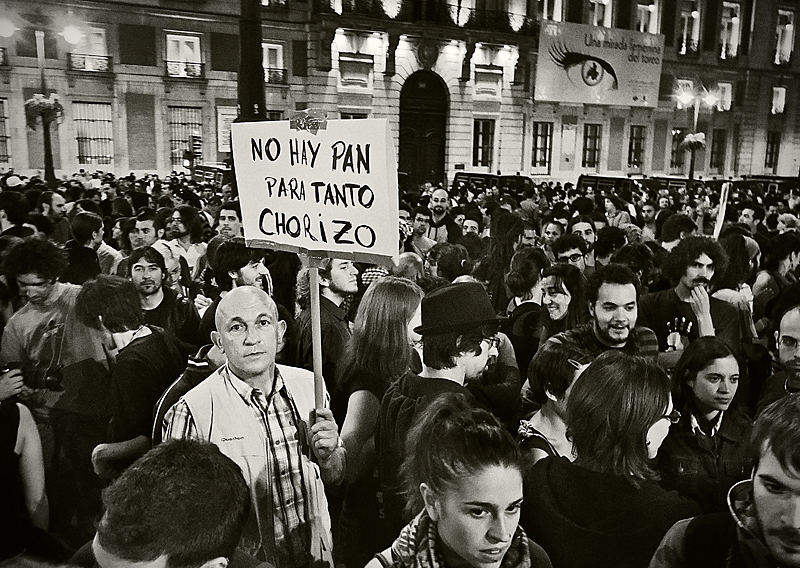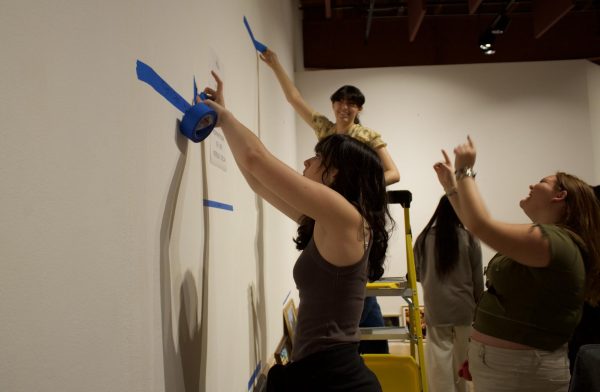15M
“Acampada en Sol” by Juan Casals. May 17th, 2011. (Photography by: J. Casals. B)
On May 15 of 2011, a peaceful protest movement was unleashed in Spanish cities, bringing together people of different political ideologies to put an end to the corrupt political system and bipartisanship. This movement is known as “15M” or “Movimiento de los indignados” (outrage movement).
Spain is a country with a complex and extensive history and the political system is the same. Spain has undergone sudden political changes of all kinds throughout its history. This country has almost always maintained a monarchy except for two brief periods in which a republican government was established, the I Spanish Republic (1873-1874) and the II Spanish Republic (1931-1939). Both did not last long and finally ended with the reestablishment of absolute monarchs or in the case of the second republic, a fascist regime.
The II Spanish Republic was the longest-lasting in its history, although it did not last a decade. The government of the II Republic was not stable and was marked by popular insurrections and the discontent of institutions that had formed a fundamental part of the state, such as the Catholic Church.
In 1936, 5 years after the establishment of the republican system, part of the army revolted against the government of the Republic causing the confirmation of two sides: the Republicans who remained loyal to the government, and the National side that defended conservative ideas, the church, the family, the fatherland and God.
This conflict was called the Spanish Civil War and lasted from 1936 to 1939 when the national side took Madrid, which was the last city to fall. After the war, a fascist dictatorship was established under Francisco Franco, which lasted from 1939 to 1975, when Franco died. During the regime, the fundamental freedoms of the Spanish people were curtailed and the absolute power of the state was maintained by Franco.
After the fascist dictatorship of Francisco Franco (1939 to 1975), democracy was restored in Spain. During what was called the “Transition Period” (transition from authoritarian regime to democracy,1975-1978), a new constitution was drafted that brought back the monarchy and established the state in the form of a parliamentary monarchy.
After the drafting of the constitution and the return to free elections, Spain’s two most influential parties PP (“Partido Popular”, conservatives) and PSOE (“Partido Socialista Obrero Español,” progressive took turns in power for decades. This two-party system that exchanged power between these two parties began to tire the Spanish citizens for various reasons including corruption. The economic crisis of 2008 was the straw that broke the camel’s back, and young Spaniards realized that they were going to be the first generation that would live worse than their parent’s generation and that the future would not offer them bright job opportunities. Job insecurity was prevalent and employment was scarce.
Spanish citizens, after so much economic instability and precariousness, took to the streets to demand real changes in politics in Spain on May 15th, 2011. They demanded the reform of the senate, change in the country’s electoral rules, senior officials’ pay, corruption, the end of bipartisanship, aid for young people to be able to become independent from their parents, and more job opportunities.
The protests lasted a week and had international repercussions as it spread to other countries such as Germany and France.
Thanks to this wave of protests, the creation of a political party that seems to heed the people’s aftershocks is boosted, and in 2014 “Podemos” arises.
“Podemos” translates to “we can,” in English. Although it was a newly created party, was gaining popularity and expanding very quickly, so quickly that by 2019 they were the second political force in Spain and were part of the coalition government with PSOE. Apart from Podemos, other new parties emerged and even some older ones that did not find their place in the bipartisan system were recovered.
The 15M brought the coalition governments and opened the country to political diversity.
But, now the task is to figure out how to give answers to the demands clamored by the protestors.
Is the left currently in danger, what is its current situation in Spain?
12 years later, is this movement still strong?
Did it really have such a profound impact on the political atmosphere as it was intended?
I was lucky enough to be able to do an interview and have an expert opinion. Angel Ramos, historian, member of the assemblies that organized the 15M, and professor of geography and history at the IES Diego Velazquez de Torrelodones, Madrid, Spain answered the following questions.
During the days of the demonstration, different profiles of people were seen. What did the demonstrators have in common?
Ramos said, “Most of the attendees were young people between 20 and 30 years old, almost all with a profile of higher or university studies, who nevertheless felt a great frustration for not having a job or for having to settle for finding precarious jobs for which they were overqualified. It is important to remember that the demonstration on May 15, 2011, was called by a citizen platform called “Youth without a future” and was seconded by other related groups. However, in addition to young people, it was also attended by families, retirees, and people of all ages who were suffering in their own flesh the consequences of the economic crisis that began in 2008.”
“The general feeling was one of indignation, which is why the movement was initially called “los indignados” (the outraged), to which the dissemination of Stephane Hessel’s book “Indignaos” contributed a lot, which became a bible for all the young people of the millennial generation, and which perfectly summarized the feeling of frustration with a system that was not giving us answers,” Ramos communicated.
After, Ramos continued, “The indignation was directed towards three very specific sectors. The first one was the political power whose actions during the crisis were focused on saving the economic power without taking citizenship into account. While unemployment was rising and cuts were being made in social assistance, health, education, etc, the government approved the payment of the debt contracted by the banks. Citizens demanded to be taken into account and therefore demanded direct participation in the political system. The second sector to which the anger was directed was economic power, the real culprit of the crisis. Financial and real estate speculation generated an enormous bubble that did not correspond to the real economy. When this bubble burst, we citizens were the first to suffer the consequences, but governments instead of judging and punishing those responsible for this speculation, what they did was to pay with public money the huge hole that caused the bankruptcy of financial institutions. And finally, the social sector, the 15M movement had a transformative intention, it was not limited to changing a government to put another, but intended a change of mentality, to improve society and the way we have to coexist with the planet. In the 15M converged another series of movements that contributed a lot, such as the feminist movement, the ecologist, LGTBI, etc.”
Has the left been able to respond to the demands and requests of the protesters?
Ramos said, “Since the movement arose, various political groups have tried to capitalize on some of the demands of the indignados. The PSOE, then in government, allowed the demonstrations and promised to take their demands into account. The PP, then in opposition, considered that it was a movement organized by the radical left and that its only intention was to destabilize the Spanish political system. Izquierda Unida did participate actively in the assemblies and demonstrations, but it did not manage to establish itself as the party that united the movement since both IU and PSOE were seen as parties of the old politics and 15M aspired to real democracy, more direct, instead of the old representative democracy.”
“If there is a political party that emerged from 15M and that tried to bring the demands of the movement to the state institutions, it was Podemos. Both in its assembly-based party structure, far from the old hierarchy of the big parties, and in its program of great social content, Podemos represented – in its origins – all those outraged citizens who demanded a change,” Ramos added.
“In its beginnings, Podemos had a program that had been drawn up in consultation with the grassroots, with a system of direct participation. It was able to capture the indignation of the people very well and with a clear and direct discourse it came to appear in the polls as the first force in voting intentions. Evidently, this scared the political and economic power elite. Podemos suffered from its beginnings a media lynching as never seen before. Accusations of being financed by Venezuela (seven times dismissed by the Supreme Court), of being an anti-system party, of being the political arm of ETA (armed Basque nationalist and far-left separatist organization in the Basque Country, between 1959 and 2018), etc., all of them false. Even to counteract its growth, a “laboratory” party was created as Ciudadanos, which pretended to be a party of “change” but with a friendlier face, more homologous to the system. Even so, Podemos obtained 69 deputies in the 2015 elections, but the PSOE’s reluctance to lose its political hegemony as the main left-wing party made a government pact impossible and the elections had to be repeated,” Ramos recounted.
“From then on the illusion generated by Podemos began to deflate, once it entered the parliamentary game and became a political party plus the support it had at the beginning was diluted. In addition, internal discussions caused the party to fragment, and other political groups emerged that weakened it, such as Más País, and Adelante Andalucía… At present Podemos has ceased to be a party that received support from voters disenchanted with the system and who wanted a change, to become a party that simply aspires to be a political force to the left of the PSOE. At present the balance is quite poor and for many people disappointing. From what was demanded in the 15M to what has been achieved with Podemos in the coalition government there is a great distance. It is true that social spending has increased, that there are policies aimed at protecting those who have the least, that most political parties now consult more with their bases, and that even the monarchy is trying to give a friendlier and more transparent face. But real democracy involving [the] direct participation of the citizenry is still to be built,” he added.
How do you organize a demonstration of this magnitude that brings together people of different political and social characteristics?
Ramos said, “If anything characterized the 15-M was its spontaneity. It all began with demonstrations called in the main cities of Spain, the largest being the one in Madrid. This began in Atocha and was intended to reach Puerta del Sol, but the volume of attendance exceeded the forecasts, about a million demonstrators crowded the march and on arrival at Sol was such a popular outcry that the police were ordered to dissolve the demonstration. It was at that moment when a group of demonstrators decided to settle in the square until their demands were heard. In the beginning, it was a group of about 5,000 people, willing to camp in the Puerta del Sol as long as necessary, as the days passed and this group did not dissolve, more people began to join them, more indignant people willing to participate in demands that they considered social justice. Since the beginning of the encampment, the movement was organized in assemblies or committees, without a hierarchical structure, with a system of direct participation in which everything was voted in the assembly. The committees or commissions were divided according to themes: education, economy, action, culture, feminism, environment, etc. They discussed the proposals that citizens proposed to improve the system and were approved or rejected in each assembly through a system of votes by a show of hands. All these proposals were recorded in minutes and then discussed in the general assembly, which was convened sometimes every two days and sometimes weekly. The general assembly was sovereign and the proposals of the different committees that were approved there were collected and became the demands that the movement intended to demand from the government. It i’s important to remember that, both in the general assembly and in the thematic assemblies, participation was open to all citizens who wanted to attend, whether they were in the encampment or not, everyone was given a voice and I remember that some speeches were memorable for the passion and authenticity with which those who suffered the harsh consequences of the crisis spoke.”
He explained, “The months that the 15-M movement lasted were an experience of direct democracy that many of us had not experienced before, an agora of Classical Greece but in the 21st century. Citizens from all walks of life participated, from university professors to the long-term unemployed, all with the intention of proposing ideas to improve people’s lives. They were all united by their indignation with the system that was leaving citizens aside, but they all wanted to do something to change it, that was the true unifying spirit of 15-M.”
How do you think the movement has aged, is it still relevant?
“The 15M movement as such is dissolved, but its demands continue to exist and remain on the agenda of almost all left-wing political parties in the country. What for now, has not emerged is that spark that mobilizes the population to organize a mass demonstration and a subsequent camping out in the center of the main cities of Spain,” Ramos said.
Ramos goes on, “If history teaches us that events are cyclical, as Mark Twain said, ‘History does not repeat itself but rhymes.’ If we live through another world crisis like the one in 2008 that stresses social peace and increases inequality it is likely that we will live through a similar event again and if the 15M has served for something it is that it taught people to organize and become aware of their power as citizens.”
Do you consider necessary a new 15M after the rise of radical right-wing movements in Spain?
“The radical right cannot be fought with demonstrations or citizen assemblies. The spirit of 15M was to be a loudspeaker for people to express themselves and contribute their ideas, while the rise of the extreme right in Western democracies responds to other factors and must be fought in another way. The extreme right does not have such a political program, its ideology is based on “Antis”, that is to say, they are anti-ecologists, anti-feminists, anti-progressives, anti-immigration, anti-homosexuals… but their political program does not bring anything new, it is very similar to that of the conservative parties of all life but with a much more aggressive and simplistic discourse that is permeating among people who want quick solutions regardless of how they are achieved. To stop the extreme right what is needed is a lot of pedagogy, teaching young people to know how to identify extremist speeches and the danger of believing in them, fighting their lies with objective facts in all possible media, and isolating them politically so that other parties do not feel the temptation to make a pact with them and thus prevent them from entering government institutions. Unfortunately, Spain is not like France or Germany, where conservative parties have made a cordon sanitaire to the extreme right and refuse to pact with them,” Ramos described.
How do you consider the current left-wing movement in Spain?
Ramos concluded and said, “I consider that the Spanish left currently has an important challenge ahead with the emergence of a new party “Sumar,” which is generating a lot of expectation and at the same time tensions within the left. Illusion because of the great charisma of its leader, Yolanda Diaz, who as Minister of Labor and 2nd Vice President has done an excellent job approving labor reform and fighting the extreme right in parliament with great dignity. On the other hand, this new party is generating tension with Podemos, which wants to remain the alternative to the left of the PSOE and has not yet decided to join the ‘Sumar’ proposal. If history teaches us anything it is that when the left fragments too much the great beneficiary is the right. Therefore, if the Spanish left wants to revalidate its victory in the next elections, it must solve as soon as possible this struggle between Podemos and Sumar to come together as a single party, otherwise, it is very likely that PP and VOX will agree to take over the government.”
This May we celebrate 12 years since 15M, a movement that marked a before and after in the political history of Spain, changing the way we understand the way of governing and uniting a whole country demanding change.
Your donation will support the student journalists of Huntington Beach High School. Your contribution will allow us to cover our annual website hosting costs.
Thank you for supporting our program!







